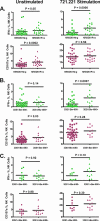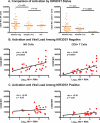Conferral of enhanced natural killer cell function by KIR3DS1 in early human immunodeficiency virus type 1 infection
- PMID: 18305035
- PMCID: PMC2346752
- DOI: 10.1128/JVI.02449-07
Conferral of enhanced natural killer cell function by KIR3DS1 in early human immunodeficiency virus type 1 infection
Abstract
A flurry of recent reports on the role of activating and inhibitory forms of the killer cell immunoglobulin-like receptors (KIR) in natural killer (NK) cell activity against human immunodeficiency virus type 1 (HIV-1) have yielded widely divergent results. The role of the activating NK receptor encoded by the KIR3DS1 allele and its putative ligands, members of the HLA class I Bw4Ile80 cluster, in early HIV-1 disease is controversial. We selected 60 treatment-naïve adults for study from the OPTIONS cohort of individuals with early HIV-1 infection in San Francisco. We performed NK cell functional assays measuring gamma interferon (IFN-gamma) and CD107a expression by NK cells in the unstimulated state and after stimulation by the major histocompatibility complex class I-deficient 721.221 B-lymphoblastoid cell line. In addition, we measured CD38 expression (a T-cell activation marker) on T and NK cells. Persons who have at least one copy of the KIR3DS1 gene had higher IFN-gamma and CD107a expression in the unstimulated state compared to those who do not possess this gene. After stimulation, both groups experienced a large induction of IFN-gamma and CD107a, with KIR3DS1 carriers achieving a greater amount of IFN-gamma expression. Differences in effector activity correlating with KIR3DS1 were not attributable to joint carriage of HLA Bw4Ile80 and KIR3DS1. We detected a partial but not complete dependence of KIR3DS1 on the members of B*58 supertype (B*57 and B*58) leading to higher NK cell function. Possessing KIR3DS1 was associated with lower expression of CD38 on both CD8(+) T and NK cells and with a loss or weakening of the known strong associations between CD8(+) T-cell expression of CD38 mean fluorescence intensity and the HIV-1 viral load. We observed that possessing KIR3DS1 was associated with higher NK cell effector functions in early HIV-1 disease, despite the absence of HLA Bw4Ile80, a putative ligand of KIR3DS1. Carriage of KIR3DS1 was associated with diminished CD8(+) T-cell activation, as determined by expression of CD38, and a disruption of the traditional relationship between viral load and activation in HIV-1 disease, which may lead to better clinical outcomes for these individuals.
Figures



References
-
- Alter, G., M. P. Martin, N. Teigen, W. H. Carr, T. J. Suscovich, A. Schneidewind, H. Streeck, M. Waring, A. Meier, C. Brander, J. D. Lifson, T. M. Allen, M. Carrington, and M. Altfeld. 2007. Differential natural killer cell-mediated inhibition of HIV-1 replication based on distinct KIR/HLA subtypes. J. Exp. Med. 2043027-3036. - PMC - PubMed
-
- Altfeld, M., and P. Goulder. 2007. ‘Unleashed’ natural killers hinder HIV. Nat. Genet. 39708-710. - PubMed
-
- Barbour, J. D., F. M. Hecht, T. Wrin, M. R. Segal, C. A. Ramstead, T. J. Liegler, M. P. Busch, C. J. Petropoulos, N. S. Hellmann, J. O. Kahn, and R. M. Grant. 2004. Higher CD4+ T cell counts associated with low viral pol replication capacity among treatment-naive adults in early HIV-1 infection. J. Infect. Dis. 190251-256. - PubMed
-
- Carr, W. H., M. J. Pando, and P. Parham. 2005. KIR3DL1 polymorphisms that affect NK cell inhibition by HLA-Bw4 ligand. J. Immunol. 1755222-5229. - PubMed
Publication types
MeSH terms
Substances
Grants and funding
LinkOut - more resources
Full Text Sources
Other Literature Sources
Medical
Research Materials

